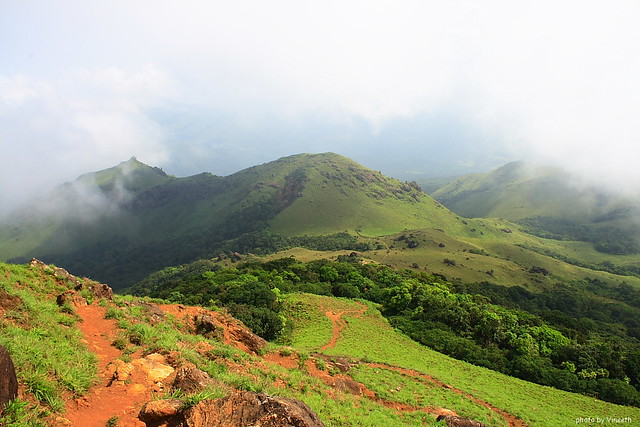Thadiyendamol stood tall. For centuries, he had been the lone sentinel, towering over lesser peaks and serving as a landmark to seafarers. The tallest peak in Coorg, on a clear day he could see as far as the coast. Over time, he had seen spices from Coorg being exchanged for salt from Kerala. He had observed also the subsequent exchange of culture. How the open shrines of Coorg acquired the typical Kerala roof. And he watched the rain god Igguthappa, along with his brothers and sister, migrate from Kerala to Kodagu. Soon after, the sky darkened. Igguthappa had smiled. Along with him, he had brought rain. A Malabar whistling thrush, his blue-black coat ruffled, was caught unawares by the fat drops of rain and his melodious off-key whistle seemed trapped inside his throat. Thadiyendamol had covered himself in a giant white cloak and disappeared from view…. Now it is just you, the amplified sounds of a rainforest come alive and a faint mountain trail, with no end in sight.

Thadiyandamol descent (Photo by vineeth.ys)
Not too long ago, this little village in the heart of the south-west Kodagu rainforest used to be the largest honey producer in South-East Asia. But a chance virus wiped out the resident bee population. What you lose on the swings, you gain on the roundabouts. This crisis deflected attention to something more than honey — the bountiful nature that produced it. Birdwatchers and backpackers soon realised that there’s more to Kodagu than Madikeri. And proceeded to march through the clouds to rediscover Thadiyendamol, and the sleepy Kodava village of Kakkabe in the shadow of the great mountain. With a landscape not tarnished by Coca Cola sign boards, Kakkabe is nature’s laboratory. It can transform a boring natural science class into an exciting practical tour. It offers interactive modules on the formation of clouds, the manufacture of honey, and the process of cross-pollination — with waterfalls, gurgling streams and treks as your break periods. The heavy rainforest cover gives the region a rich bounty of rare orchids, plants and birds. Scenic treks take you to Mallamma Betta, Soma Male and Kabbe Pass, from where you can spy sun-kissed clouds caressing Kerala’s hills. However, the prize catch undoubtedly is Thadiyendamol.

Thadiyendamol (Photo of binux)
There’s something awe-inspiring about the name itself. Derived from Malayalam to loosely mean ‘I’m the Tallest’ (thadi means broad, yenda is mine and mol is top), Thadiyendamol, at 5,730 ft, is the highest peak in Coorg and the second highest in Karnataka after Mullaiyanagiri in the Baba Budan Range. Thadiyendamol lures trekkers with the promise of a glimpse of the coastline on a clear day. For the most part, the trek is gentle, but the last quarter is a steep climb. The 21/2-hr climb (one-way) from Palace Estate (see page 132) is shorter, but the longer 31/2-hr climb from Honey Valley Estate passes through thick rain forest and more scenic terrain.
Fast Facts
State: Karnataka
Location: Kakkabe lies at the base of the Western Ghats in southern Kodagu
Distance: 264 km SW of Bengaluru; Journey time: by road 7.5 hrs
When to go: Kakkabe is accessible throughout the year, but avoid July- August when the rainforest receives heavy showers and teems with leeches. The post-monsoon months are extremely rewarding for birdwatchers as the birds return to their usual perches. Ideal season is between September and May.
By Anurag Mallick
About the Author: Anurag Mallick is a nomad at heart and writer by choice.



